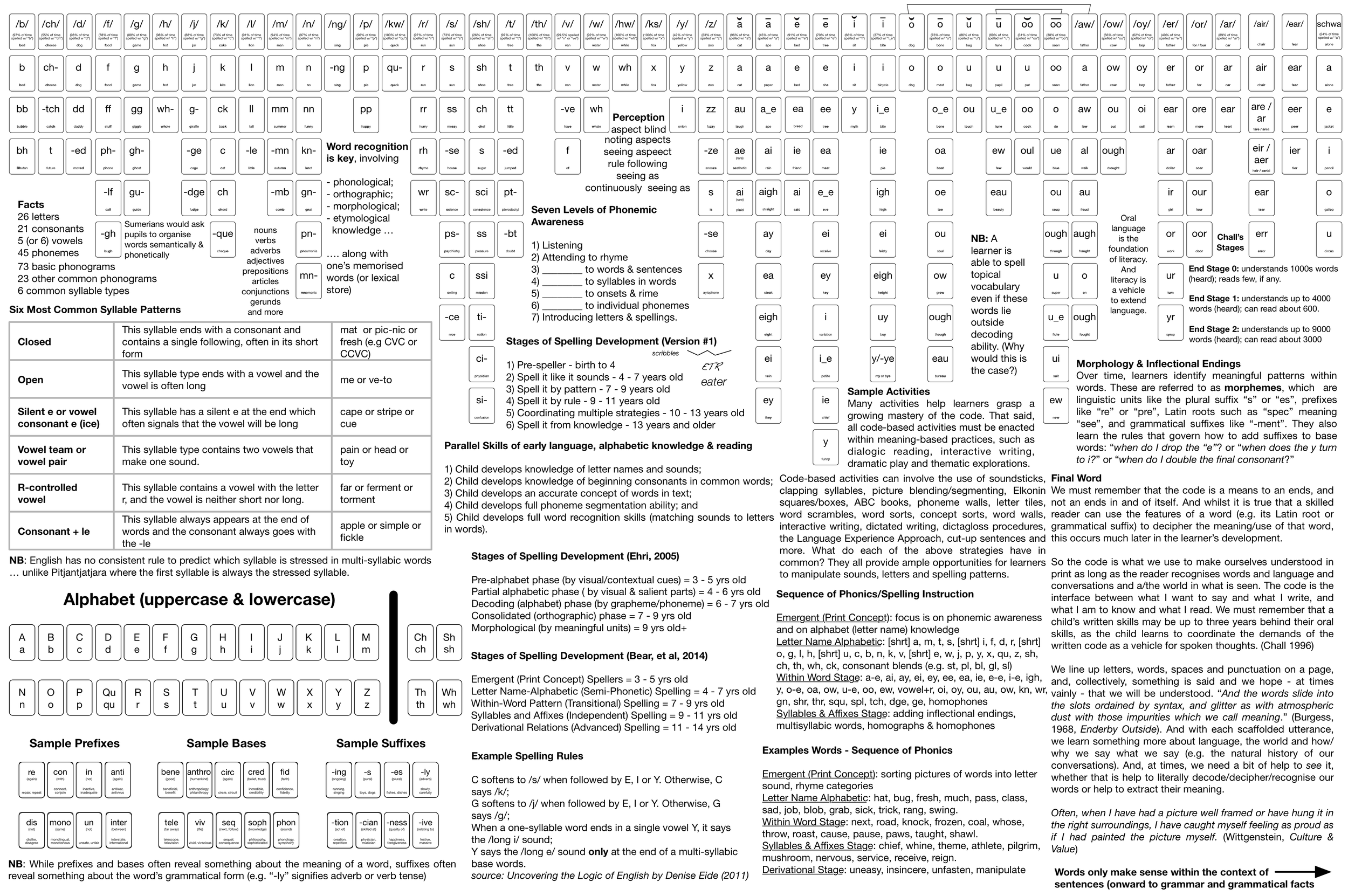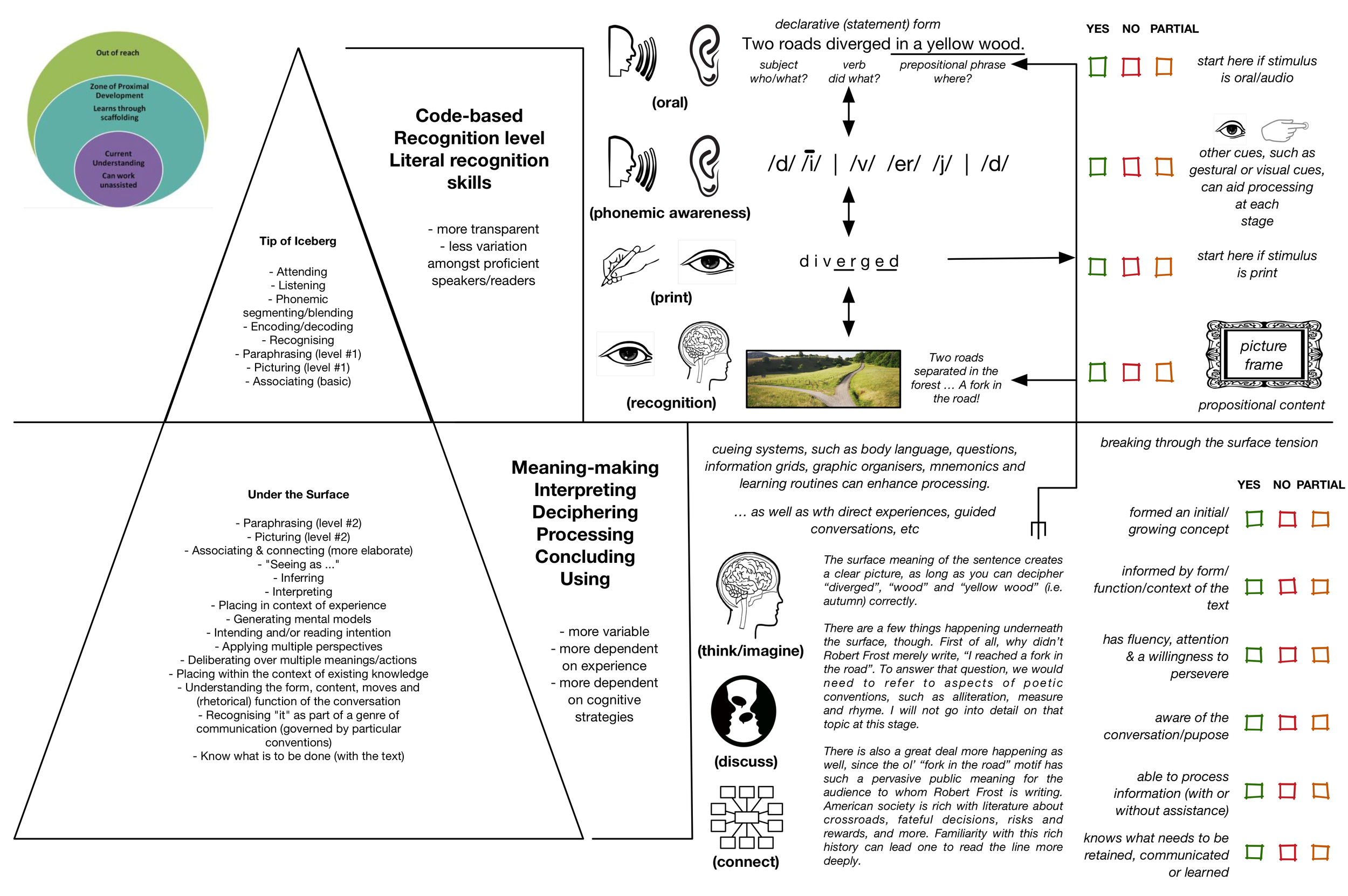When language-games change, then there is a change of concepts, and with the concepts the meanings of words change. (On Certainty, #65)
In the previous blog post, I mentioned that Wittgenstein’s Tractatus Logico-Philosophicus was his flawed masterpiece. And I went on to write that “it is flawed only in the sense that our human language consists of a greater variety of propositions than merely descriptive sentences. We tell jokes. We ask questions. We talk about abstract things. We create rules and so on.”
I’d like to spend this post focusing on Wittgenstein’s attempt to rectify these flaws in his later work, particularly in the Philosophical Investigations. Even more specifically, I’d like to write about his language games concept, since it sheds light on the diversity of language practices learners are asked to adopt over time.
Even before I do that, I’d like to justify my reason for pursuing this rabbit hole. Whilst Wittgenstein is not contemporary literacy research, The Literacy Bug was set up to explore ideas as much as it was set up to share evidence-based practices. Here, I’d like to continue exploring how we use oral and print language to help us render and - even - organise our experience of and interactions with the world.
So here we go … let’s revisit the last blog post again. In it, I wrote,
“If we take a moment to consider descriptive sentences, there is an elegant and meditative quality to the acts of writing and reading. In the acts of writing and reading, we are builders. We are builders of experiences. We are speculators on cause and effect.”
Let’s call this a language game. It is one language game amongst many in our daily lives. Let us define a language game as a particular use of language implicitly governed by certain rules and accepted (by a language community) as serving a certain function or purpose. Certain learners - such as certain children - are raised in an environment in which there is a particular value placed on particular uses of language, such as - say - describing (painting in words) a scene - real or imagined - in exacting detail for consideration. And there will be other contexts - such as in school - that this use of language will be rewarded, reinforced and extended. In this community, there is certain training and praise for this skill, but there are also repercussions if a learner becomes careless or inattentive in this language game, or form of discourse. As suggested by Garver,
"It is ... possible to instruct people in the use of the language. Such instruction involves correction and drill that aims at some (unspecified) level of competence. It is no doubt pursued more doggedly and more dogmatically in some cultures than others." (Garver, 1996, pg 165)
A learner must become both skilled in this language game - of descriptions, in this case - but also motivated to do so in the appropriate circumstances, as suggested by Stanley Cavell, “the pupil must want to go on alone in taking language to the world." (Cavell, 2005, pg 115) And so, the learner is initiated into a particular use of language that the learner will turn to when the time is right. Upon initiation, a certain practice has been established. As stated in our essay Establishing Practices, the features of a practice are as follows:
“At the very least, a practice is something people do, not just once, but on a regular basis. But it is more than just a disposition to behave in a certain way; the identity of a practice depends on not only on what people do, but also on the significance of those actions and the surroundings in which they occur." (Stern, 2004, p. 166)
In a practice, what becomes necessary is the individual's "willingness to engage with such activities in a particular way, thus changing ‘mere’ activities into practices where standards of excellence do matter.” (Smeyers and Burbles, 2010 pg 196)
“Our deliberations seem to be entirely personal and self determined - yet they obviously derive from previous conversations with others, in which their voices and perspectives are represented in one’s own internal deliberations. Often this dynamic is what we call ‘conscience.’” — (Burbles and Smears, 2010, pg 180)
Therefore, “every instance of the use [or participation in a practice] … is the culmination of a process of socialisation.” (Phillips, 1979, pg 126).
That all might seem quite long-winded for a relatively simple point: children learn to describe (as one use of language) and children come to develop other uses of languages as well. As teachers, we want our learners to become skilled in many uses of language (describing, recounting, explaining, comparing, narrating, critiquing, etc). This is true, but I think Wittgenstein refers to something more important here. He is interested in how we turn to particular uses of language to solve problems in daily lives. This requires both skill and the ability to recognise the circumstances in which to deploy a particular language game and why. James Paul Gee explains these two levels as two levels of discourse:
“I will use ‘discourse’ [with a lower case "d"] for connected stretches of language that makes sense, like conversations, stories, reports, arguments, essays and so forth. So, ‘discourse’ [the spoken or written text] is part of the ‘Discourse’ – ‘Discourse’ [with a capital “D”] is always more than just language.[The] Discourses are ways of being in the world, or forms of life which integrate words [integrate little “d” discourse], acts, values, beliefs, attitudes and social identities as well as gestures, glances, body positions and relationships.” (Gee, 1996, p 127)
For instance, we’d want to encourage learners to “stop, consider, describe” when faced with a problem that requires one to outline and examine all the various factors and variables in a scenario, and we’d need to consider how language is used to navigate such a way of thinking AND a way of working with others. Teaching includes providing the scaffolding which supports the turns/sequences in the game. And like any game, we want learners to play this game many times so they are able to discover the nuances in the game and to generalise the rules from the game.
Figure 1: Source: Florida Centre for Reading Research
Figure 1 is an example of a paper-based scaffold that makes explicit the cognitive architecture - or schema - of a particular way of analysing a text. This way of analysis would be an example of a language game. The scaffolding (or guidance) that a teacher provides can also consist of particular activities, axioms, mnemonics, reminders, hints, routines and encouragement, which are essential to ensuring successful completion of the task. Ultimately, all of this modelling and guidance teaches the learners to go on in a particular manner, which involves a whole raft of moves, turns, checkpoints and further points for deliberation.
Then, am I defining “order” and “rule” by means of “regularity”? ... I shall teach him … by means of examples and by practice. -- And when I do this I do not communicate less to him than I know myself. In the course of this teaching I shall shew him … get him to continue a … pattern when told to do so. -- And also to continue progressions. And so … I do it, he does it after me; and I influence him by expressions of agreement, rejection, expectation, encouragement. I let him go his way, or hold him back; and so on. (Philosophical Investigations, #280)
So, being initiated into such a practice - therefore - involves the internalising of - what we might call - deliberative talk. For instance, the philosopher Ludwig Wittgenstein models this aspect by presenting the inner monologue of a character who is building something:
Every now and then there is the problem “Should I use this bit?” — The bit is rejected, another is tried. Bits are tentatively put together, then dismantled; he looks for one that fits etc, etc.. So I sometimes make him say “No, that bit is too long, perhaps another’s fit better.” — Or “What am I to do now?” — “Got it!” — Or “That’s not bad” etc. … (Wittgenstein, Zettel #100)
Diversity of language games
Consider all the language games which serve to mediate daily lives ... from “morning news” to planning meetings to personal reflection to prayer to meditative poetry to following instructions and much, much more. Learning these games involves the ability to focus attention, participate in the game, and demonstrate an appreciation of how such engagement is purposeful in some way.
Throughout students’ academic, social and moral careers, they must navigate and negotiate through many different and even conflicting discourses (or ways of using language) in order to participate and advance in multiple contexts, school only being but one of them. Navigating through discourses involves anything from understanding the forms and functions of significant linguistic practices, to being sensitive to the conventions of speaking in particular contexts, to critically assessing the assumptions and outcomes of language practices in society.
Guiding students through these subtle areas of language development is complex, and involves more than the teaching of specific language features (phonology, grammars, vocabularies, and structures). It involves initiating students into a growing repertoire of ways of using language to perform different roles with language, whether in constructing knowledge, imaginative recreation, construing activity, or actively impacting the world and the people around them. The very nature of this process of initiation becomes the concern of how literacies (ways of reading, interacting and being through language and communication) are transmitted, formed and engaged in within pedagogical relations amongst people, whether it be between mother-child, teacher-student, co-worker-co-worker, elder-youth, author-reader, institutions-individuals, etc (Bernstein, 2000).
One more thing …
There is something that Wittgenstein raises that often isn’t included in the educational literature: he asks us to explore what happens when a complex *language game* is adopted which is - in fact - destructive. Let’s consider either racist discourse or defeatist discourse, which are both language games that can become habitual and exert a powerful shaping force on how one navigates the world. Racist discourse doesn’t necessarily require further explanation, but defeatist discourse may. In defeatist discourse, a person may learn to self-sabotage any hopes of success by entrenched habits of doubt. Wittgenstein would tell us that philosophy seeks to free ourselves from the “bewitchment” of language by revealing the bewitching patterns of language use and proposing alternatives (e.g. showing the fly the way out of the bottle). However it is not so easy, since it requires the learner to take the brave step of trying to alter the “ruts” of language.
If we switch to an educational example, a learner may not be asking the right questions or sequence of questions that an expert would when trying to get the most out of a topic. Consequently, the learner may be failing to make any forward momentum in an area of learning. At some point, though, the learner encounters a teacher who guides him or her in asking “the right questions” which come to “reshape the nature of the investigation” and the potential for learning. This new language game or revision of an old language game opens up the possibility for discovery.
Bringing things closer to a close
How - then - does all this relate to literacy, you may ask? Well, it relates to the central issues of comprehension and composition. Even if one has learned the “basics”, such as decoding and grammatical competence, there are many higher order linguistic issues to attend to if one is going to read and write for the diverse purposes in life.
As James Paul Gee more simply reminds us, “We have to worry about what texts students have read and how they have read them, not just about how much they have read and how many books they do or do not own (though, of course, these are important matters).” (Gee, 2003, pg 30-31)
Because,
“After all, we never just read "in general", rather, we always read or write something in some way. We don't read or write newspapers, legal tracts, essays in literary criticism, poetry, or rap songs, and so on and so forth through a nearly endless list, in the same way. Each of these domains has its own rules and requirements.” (Gee, 2003, pg 28)
As Wittgenstein would also,
PI 156: The use of this word [to read] in the ordinary circumstances of our life is of course extremely familiar to us. But the part the word plays in our life, and therewith the language-game in which we employ it, would be difficult to describe even in rough outline. A person, let us say an Englishman, has received at school or at home one of the kinds of education usual among us, and in the course of it has learned to read [basically] his native language. Later he reads books, letters, newspapers and other things.
In closing
On that note, I’d like to end. This essay has been written in the spirit of the original definition of the French "essai" - coined by Michel de Montaigne - which means to try/attempt/trial ... to seek new ways to explore and/or articulate relevant issues. I hope this digression is of some benefit/use. On behalf of *The Literacy Bug* and until next time, please enjoy and explore!
References
Bernstein, B. (2000). Pedagogy, symbolic control and identity: theory, research, critique. Maryland: Rowman & Littlefield Publishers.
Burbles, N., & Smears, P. (2010). The practice of ethics and moral education. In M. Peters, N. Burbles, & P. Smears (Eds.), Showing and doing: Wittgenstein as a pedagogical philosopher (pp. 169 – 182). London: Paradigm Publishers.
Cavell, S. (2005). Philosophy the day after tomorrow. In Philosophy the day after tomorrow (pp. 111 – 131). Cambridge, MA: Belknap Press.
Garver, N. (1996). Philosophy as grammar. In H. Sluga, H. and D. Stern (Eds.), The Cambridge companion to Wittgenstein. (pp. 139 - 170) Cambridge: Cambridge University Press.
Gee, J (1999). An introduction to discourse analysis: theory and method. London: Routledge.
Gee, J. P. (2003). Opportunity to learn: a language-based perspective on assessment. In Assessment in Education: Principles, Policy and Practice, Vol 10, No. 1, pp 27 - 46.
Phillips, D. (1977) Wittgenstein and scientific knowledge. London: MacMillan Press.
Smeyers, P., & Burbles, N. (2010). Education as initiation into practices. In M. Peters, N. Burbles, & P. Smeyers (Eds.), Showing and doing: Wittgenstein as a pedagogical philosopher (pp. 183 – 198). London: Paradigm Publishers.
Stern, D. (2004). Wittgenstein’s Philosophical Investigations: an introduction. Cambridge: Cambridge University Press.
Wittgenstein, L. (2001a). Tractates Logico-Philosophicus. Translated by D.F. Pears and B.F. McGuinness. London: Routledge.
Wittgenstein, L. (2001b). Philosophical Investigations. 3rd Edition. Translated by G.E.M. Anscombe. Oxford: Blackwell Publishing.
Wittgenstein, L. (1967). Zettel. (G. E. M. Anscombe & G. H. von Wright, Eds.). Berkeley, CA: University of California Press.
Wittgenstein, L. (1969). On Certainty. Edited by G.E.M. Anscombe and G.H. von Wright. Translated by D. Paul and G.E.M. Anscombe. New York: Harper Torchbooks.







